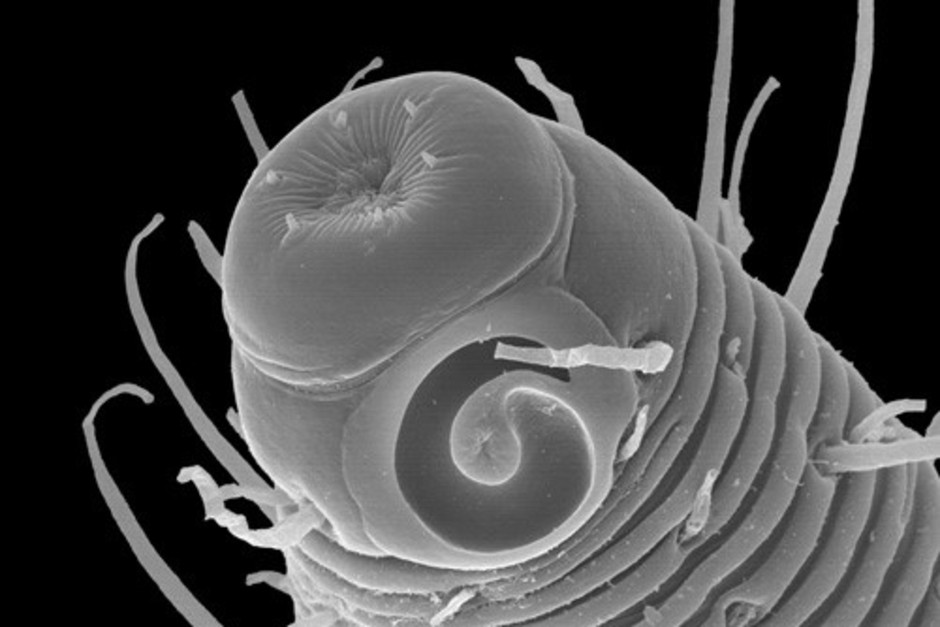Forskningsområden: Zoologi
Forskningsämnen: Biodiversitet, Evolution, Fylogeni, Taxonomi & artbeskrivning
Project overview
Project period: 2011 - ongoing
Participating departments from the museum: Zoology
Nematodes are the most numerous multicellular animals on the planet and play an important role in nature and human life, in particular as parasites of humans, and as pests of crops and farmed animals. Naturally, due to their medical and agricultural importance, parasitic nematodes attract the majority of scientific attention, while the rest of Nematoda remain poorly studied.
Comprehensive understanding of the origin and evolution of nematodes cannot be achieved without good knowledge of the biology of free-living species, which can only be accomplished by combining classical zoological methods with modern tools in molecular systematics and bioinformatics.
Project description
There are about 28 000 species of nematodes described, while the total estimated number of species is between 100 000 and several millions. We focus our research on poorly known groups of nematodes, in particular those inhabiting deep sea, deserts, tropical rain forest, sea ice or are symbionts of other animals. Naturally, such poorly studied environments often harbour unknown species that we describe as new to science.
By using morphological (light and scanning electron microscopy) and molecular (single genes, transcriptomes and genomes) data we reconstruct the relationships between different groups of nematodes and how they evolve in different environments. We even study fossil nematodes that are found in amber and in Rhynie chert (lower Devonian deposits). Sometimes we also investigate the biology of particularly interesting species.
For example, we study how fast nematodes mutate under extreme conditions in the deserts, or which mode of reproduction (sexual or asexual) is more successful for nematodes. Another topic of particular interest is the diversity of parasitic nematodes that infect invertebrate animals and how they are related to their free-living ancestors.
Funding
- Svenska artprojektet
 External link.
External link. - Norska artsprosjektet
 External link.
External link. - Stiftelsen Anna och Gunnar Vidfelts fond för biologisk forskning
 External link.
External link. - National Science Foundation
 External link.
External link.
Selected publications
- Ahmed, M., Roberts, N.G., Adediran, F., Smythe, A.B., Kocot, K.M. & Holovachov, O. (2022). Phylogenomic analysis of the phylum Nematoda: conflicts and congruences with morphology, 18S rRNA and mitogenomes. Frontiers in Ecology and Evolution 9, 769565. https://doi.org/10.3389/fevo.2021.769565
 External link.
External link. - Ahmed, M. & Holovachov, O. (2021). Twenty years after De Ley & Blaxter – how far did we progress in understanding the phylogeny of the phylum Nematoda? Animals 11, 3479. https://doi.org/10.3390/ani11123479
 External link.
External link. - Smythe, A.B., Holovachov, O. & Kocot K.M. (2019). Improved phylogenomic sampling of free- living nematodes enhances resolution of higher-level nematode phylogeny. BMC Evolutionary Biology 19, 121. https://doi.org/10.1186/s12862-019-1444-x
 External link.
External link. - Holovachov, O., Haenel, Q., Bourlat, S.J. & Jondelius, U. (2017). The choice of taxonomy assignment approach has strong impact on the efficiency of identification of OTUs in marine nematodes. Royal Society Open Science 4, 170315. https://doi.org/10.1098/rsos.170315
 External link.
External link.
Project members
Sven Boström | Research associate
Enheten för Zoologi
Mohammed Ahmed | ZOO (2019–2022)
External participants
- Philipp Schiffer’s lab, Institute for Zoology, University of Cologne, Germany, https://worm-lab.eu
 External link.
External link. - Mark Blaxter, Erna King, Darwing Three of Life, Wellcome Sanger Institute, UK, https://www.darwintreeoflife.org/
 External link.
External link. - Ashleigh Smythe, Virginia Military Institute, USA, https://nematoda.myspecies.info/
 External link.
External link. - Kevin Kocot, Department of Biological Sciences and the Alabama Museum of Natural History, University of Alabama, USA, https://www.kocotlab.com/
 External link.
External link. - Francisco Nascimento, Institutionen för ekologi, miljö och botanik, Stockholms universitet, Sverige https://www.su.se/profiles/fnasc-1.192288
 External link.
External link. - Luca Eszter Balog, Eotvos Lorand University, Ungern
- Vanessa Pitusi, The University Centre in Svalbard, Norge
Project manager


